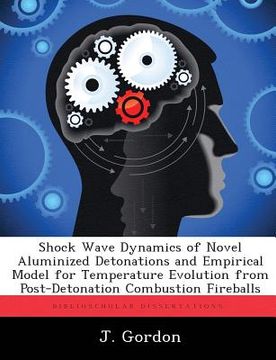Compartir
Shock Wave Dynamics of Novel Aluminized Detonations and Empirical Model for Temperature Evolution from Post-Detonation Combustion Fireballs (en Inglés)
J. Gordon
(Autor)
·
Biblioscholar
· Tapa Blanda
Shock Wave Dynamics of Novel Aluminized Detonations and Empirical Model for Temperature Evolution from Post-Detonation Combustion Fireballs (en Inglés) - Gordon, J.
$ 48.80
$ 57.95
Ahorras: $ 9.15
Elige la lista en la que quieres agregar tu producto o crea una nueva lista
✓ Producto agregado correctamente a la lista de deseos.
Ir a Mis ListasSe enviará desde nuestra bodega entre el
Lunes 15 de Julio y el
Martes 16 de Julio.
Lo recibirás en cualquier lugar de Estados Unidos entre 1 y 3 días hábiles luego del envío.
Reseña del libro "Shock Wave Dynamics of Novel Aluminized Detonations and Empirical Model for Temperature Evolution from Post-Detonation Combustion Fireballs (en Inglés)"
This research characterizes the blast wave and temperature evolution of an explosion fireball in order to improve the classification of aluminized conventional munitions based on a single explosive type such as RDX. A drag model fit to data shows initial shock velocities of 1.6-2.8 km/s and maximum fireball radii ranging from 4.3-5.8 m with most of the radii reached by 50 ms upon detonation. The Sedov-Taylor point blast model is fitted to data where a constant release (s=1) of energy upon detonation suggests shock energies of 0.5-8.9 MJ with blast dimensionalities indicative of the spherical geometry (n 3) observed in visible imagery. An inverse correlation exists between blast wave energy and overall aluminum content in the test articles. Using a radiative cooling term and a secondary combustion term, a physics-based empirical model is able to reduce 82 data points to five fit parameters to describe post-detonation combustion fireballs. The fit-derived heat of combustion has a 96% correlation with the calculated heat of combustion but has a slope of 0.49 suggesting that only half of the theoretical heat of combustion is realized. Initial temperature is not a good discriminator of detonation events but heat of combustion holds promise as a potential variable for event classification.
- 0% (0)
- 0% (0)
- 0% (0)
- 0% (0)
- 0% (0)
Todos los libros de nuestro catálogo son Originales.
El libro está escrito en Inglés.
La encuadernación de esta edición es Tapa Blanda.
✓ Producto agregado correctamente al carro, Ir a Pagar.

